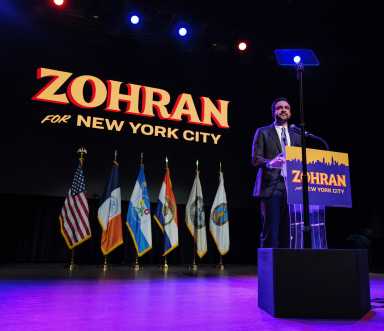Queens’ District 24 Highlights Mamdani’s Stark Divide Between Jamaica Hills Enthusiasm and Kew Gardens Hills Rejection

A landslide mayoral victory marred by fierce local divides in Queens portends challenges for governing a fragmented New York.
Zohran Mamdani garnered over 1 million votes to sweep into Gracie Mansion—breaking an electoral threshold untouched since John Lindsay in 1969—yet his resounding citywide mandate masks precincts of resistance that bristle against his brand of democratic socialism. Nowhere was this more glaring than in Queens’s Council District 24, where blocks mere minutes apart delivered diametrically opposite verdicts on the city’s new mayor: Jamaica Hills handed Mamdani his most lopsided wins, while neighboring Kew Gardens Hills gave him his most bruising defeats. For the 94.7% of voters who cast their ballots for Andrew Cuomo in ED 27, Mamdani was not just unconvincing, but unwelcome.
The contours of this fissure are instructive. Mamdani, a torchbearer for the Democratic Socialists and a vocal critic of Israeli policy, surged to victory in progressive bastions such as Astoria, Long Island City, and Sunnyside, his pledges of free buses, universal childcare, and a sweeping rent freeze for a million tenants striking a resonant chord. Yet in pockets like Kew Gardens Hills—whose streets are festooned with Israeli flags and synagogues—he was trounced. There, his strident opposition to Israel alienated an Orthodox Jewish constituency for whom such positions are more than abstract geopolitics.
Such micro-geographies reveal the shakiness of the city’s supposed unity. Mamdani’s margin of victory in Jamaica Hills exceeded 70% in multiple election districts, the strongest signal yet of a new leftward gravitational pull in parts of outer-borough Queens. Yet, just 1.5 miles away, Kew Gardens Hills delivered the inverse: not simply support for Cuomo, but explicit repudiation of the mayor-elect, reminiscent of Giuliani-era margins among ethnic enclaves who felt sidelined by city progressivism.
These divides hint at both the promise and peril confronting City Hall. For Mamdani, whose legislative wishlist (from rent freezes to childcare) will demand citywide consensus and not just electoral arithmetic, the task is daunting. Queens, which handed him his weakest borough-wide numbers outside of Staten Island, remains fractious—a laboratory for the sharp contrasts shaping New York’s political map.
Cuomo’s remarkable performance as an independent—pulling more votes than any mayoral challenger since Rudy Giuliani in 1993—suggests that dissatisfaction with status-quo progressivism runs deeper than many in party headquarters care to admit. In neighborhoods like Bayside and Howard Beach, as well as the stronghold of Kew Gardens Hills, voters rebuffed the language and policy prescriptions of the city’s new mayor by overwhelming margins. It is plausible that such rebukes hold lessons for the durability of left-leaning coalitions, whose reach, while formidable, remains uneven at the margins.
Observers will note that Mamdani’s best and worst neighborhood showings encapsulate much of the city’s present social tension. The Orthodox Jewish community’s outsized opposition—rooted less in bread-and-butter concerns than in cultural and foreign-policy anxieties—illustrates the degree to which local politics can be overtaken by global fears. Rabbi Mayer Waxman, of the Queens Jewish Community Council, has noted that Mamdani’s stance “made it untenable to support the Democratic nominee,” a view that echoes beyond a single election district.
A fractured city, mirrored in miniature
What bodes for the city bodes, in some measure, for the country. America’s major cities—all wrestling with rising polarization, rent anxiety, and fractured ethnic coalitions—are laboratories of multi-layered discontent. In New York, the proximate juxtaposition of political extremes within walking distance underscores a national reality: that voting maps are not only tribal but, increasingly, produced by feedback loops of identity and grievance. New York’s latest election saw record numbers for both leftward and centrist candidates, a harbinger of the “big tent” fraying as it becomes more capacious.
Elsewhere—Los Angeles, Chicago, Boston—the pattern repeats: buoyant progressive majorities tempered by enclaves of resistance, often clustered by ethnicity, religion, or income. The outlines may blur at the edges, but the pattern holds: grand electoral triumphs coexist with pockets of puny support, making the mechanics of governance less about citywide appeal and more about painstaking coalition management.
While the language of unity and “one city” remains a mayoral staple, the Mamdani era begins without a citywide consensus. His margin masks the steep price of ignoring ideological enclaves whose grievances—real or perceived—have the power to upend even the largest majorities. A project of redistributive ambition, however popular among the city’s youth and renters, will falter if it is greeted with outright hostility by well-organized voting blocs. For a city accustomed to noisy schisms, this fragmentation now feels existential.
We would do well to heed the lessons of this tale of two districts. Political mandates in sprawling metropolises are both gargantuan and fragile, nurtured in broad strokes and imperiled by local intensity. Mamdani, buoyed by his historic total yet wounded by his outright rejection in places like Kew Gardens Hills, enters office on notice: the city he governs is not, and never has been, a monolith. Herrings of optimism aside, the real work for any New York mayor has always started the morning after the votes are counted.
The city’s new leader finds himself at the helm of a polity half in celebration, half in protest; for Mamdani and for New York, the next four years will show whether a fractured majority can be made to govern at all. ■
Based on reporting from QNS; additional analysis and context by Borough Brief.